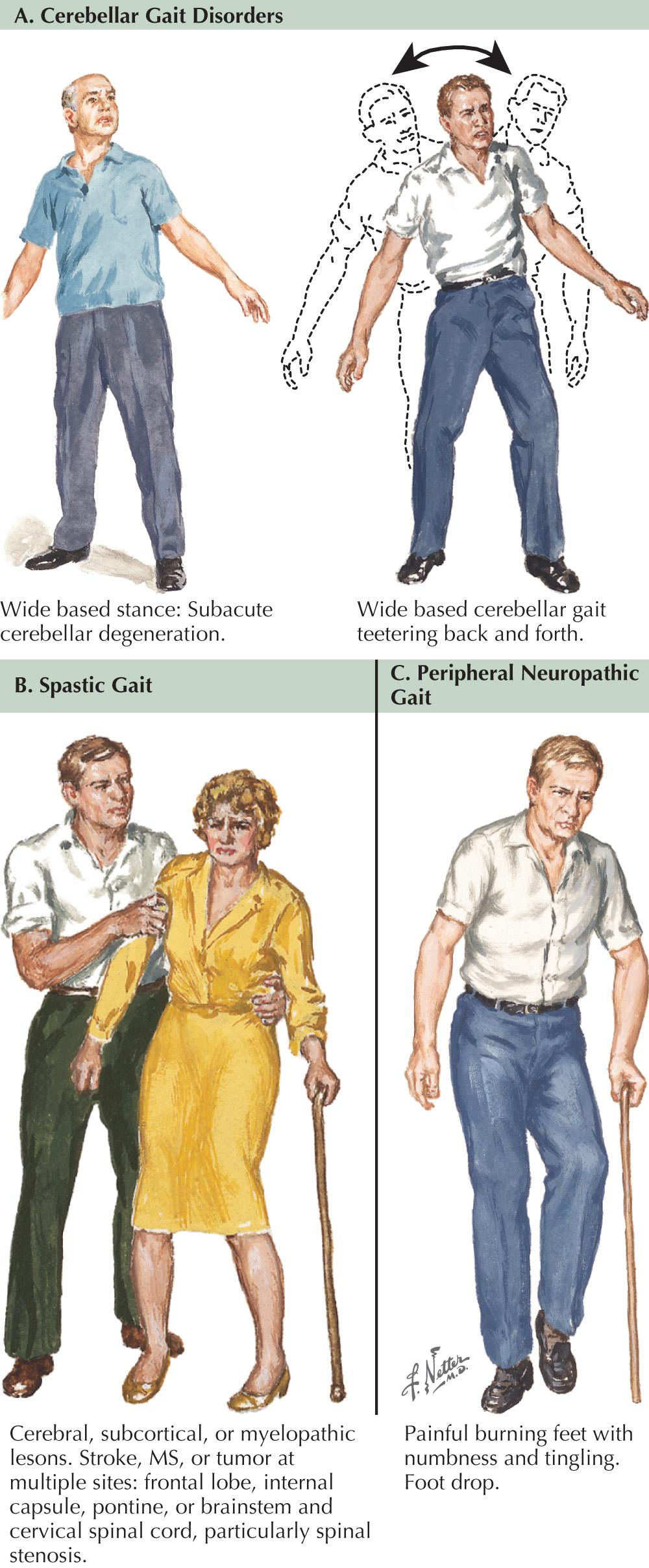Physical Address
304 North Cardinal St.
Dorchester Center, MA 02124
A 70-year-old woman presented with a 2-year history of gait slowness and unsteadiness. She sustained several falls, usually backward. She began using a cane 1 year ago. She has noticed difficulty standing up or getting out of her car. Her husband described her walking as if “her feet are glued to the floor.” In addition to her gait difficulties, she has developed urinary frequency and had one episode of urinary incontinence. She also described being more forgetful.
Neurologic exam was notable for a slow, shuffled, broad-based gait with shortened stride length and en bloc turning. Arm swing was intact. When the patient was quickly pulled backward, she demonstrated marked postural instability with retropulsion. She could not arise from a chair without using her arms to push herself up. Cognitive testing was notable for limited object recall and executive dysfunction.
The patient underwent brain magnetic resonance imaging (MRI), which revealed an enlarged ventricular system out of proportion to the degree of brain atrophy. A large-volume lumbar puncture was performed, and the patient demonstrated marked improvement in her gait and balance afterward. A ventriculoperitoneal shunt was placed with subsequent sustained improvement in the patient's gait. She also experienced mild improvement in her urinary function. Her cognitive functioning was relatively unchanged.
Gait disorders are a common presentation of neurologic disease, and their prevalence increases with age. In a cross-sectional study of 488 community-residing subjects aged 60–97 years of age, 32.2% presented with an impaired gait. Twenty-four percent of participants exhibited neurologic gait disorders, 17.4% experienced nonneurological gait disorders, and 9.2% had combinations of both. Those with neurologic gait disorders were three times more likely to experience recurrent falls. Neurologic gait disorders were also significantly associated with cognitive dysfunction, depressed mood, and diminished quality of life.
Normal gait requires the integration and coordination of the central and peripheral nervous systems and the musculoskeletal system. Gait consists of two key components: (1) locomotion, the generation and maintenance of rhythmic stepping, and (2) equilibrium, the ability to keep the body upright and maintain balance. In quadrupedal animals, locomotion is mainly dependent on spinal pattern generators, which produce rhythmic stepping movements. In contrast, locomotion in primates can be elicited by electrical stimulation of brainstem areas, including the posterior subthalamus, dorsal and ventral portions of the caudal pons, and the mesencephalic tegmentum. The latter includes the pedunculopontine nucleus (PPN), a group of cholinergic neurons that receives input from the basal ganglia and motor cortex and projects to the spinal cord and reticular nuclei. Although the exact function of the PPN is not clear, it is uniquely situated to modulate the influence of the basal ganglia on locomotion and balance. Higher cortical centers are also important in the maintenance of gait and balance. The frontal cortex is implicated in the control, coordination, and planning of automatic and voluntary movements. In addition, the posterior parietal cortex is involved in the perception of body position and posture.
Because gait is dependent on the proper functioning and integration of different aspects of the nervous system, a variety of lesions in the central and/or peripheral nervous systems can produce walking difficulties. In a recent series of 120 patients presenting to an outpatient neurology clinic with gait disorder in which patients with hemiparesis, known Parkinson disease (PD), neuroleptic exposure, and orthopedic deformity were excluded, the distribution of etiologies was as follows: myelopathy (17%), sensory deficits (17%), multiple infarcts (15%), parkinsonism (12%), hydrocephalus (7%), cerebellar dysfunction (7%), psychogenic (3%) and toxic/metabolic causes (3%).
Gait disorders can be classified in a number of ways: etiologically ( Box 38.1 ), anatomically ( Box 38.2 ), and clinically ( Table 38.1 and Fig. 38.1 ). Perhaps the most useful approach to understanding gait disorders is a clinicoanatomic one. According to this method, gait disorders can be divided into roughly three anatomic categories: cortical, subcortical, and peripheral. A variety of well-defined clinical gait syndromes can be described under each anatomic rubric.
Cervical spondylosis
Vitamin B 12 deficiency
Demyelinating diseases (e.g., multiple sclerosis)
Infectious diseases (e.g., human T-lymphotropic virus type 1 infection)
Parkinson disease
Atypical parkinsonism
Progressive supranuclear palsy
Corticobasal ganglionic degeneration
Dementia with Lewy body disease
Secondary parkinsonism
Neuroleptic-induced parkinsonism
Stroke
Vasculitis
Mitochondrial disease
Communicating
Normal pressure hydrocephalus
Noncommunicating
Toxic-metabolic
Alcohol-induced cerebellar degeneration
Medications (e.g., phenytoin)
Thiamine deficiency
Heredodegenerative disorders
Spinocerebellar ataxias
Fragile X-tremor-ataxia syndrome
Infectious/postinfectious diseases
Paraneoplastic disorders
Celiac sprue
Peripheral neuropathy (e.g., diabetic neuropathy)
Dorsal root ganglionopathy (e.g., Sjögren syndrome)
Posterior column lesions (e.g., tabes dorsalis)
Vestibular disorders
Visual disorders
Frontal/cortical
Subcortical-hypokinetic
Subcortical-hyperkinetic
Pyramidal
Cerebellar
Vestibular
Neuropathic
Myopathic
Orthopedic
| Gait Type | Clinical Features | Associated Findings |
|---|---|---|
| Frontal gait | Wide based Shortened stride length Reduced heel strike Start and turn hesitation Retropulsion |
Frontal-release signs Cognitive impairment Behavioral changes Urinary disturbance |
| Cautious gait | Mildly wide based Shortened stride Improvement with assistive device |
Anxiety Fear of falling Fear of open spaces |
| Psychogenic gait | Bizarre, inconsistent movements Lurching and knee-bucking but rare falls Distractibility/entrainment of movements |
Abrupt onset/resolution Positive psychiatric features Secondary gain Wide fluctuations over short time periods |

Become a Clinical Tree membership for Full access and enjoy Unlimited articles
If you are a member. Log in here